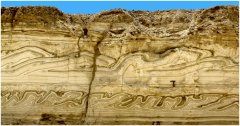
Professor Ian Alsop, University of Aberdeen
Text books frequently suggest that sedimentary slump folds are “characteristically chaotic” and display “little symmetry” (Van der Pluijm & Marshak 2004) or that “folds do not propagate …. in any systematic predictable manner” (Davis & Reynolds 1996). However, is this really the case? Using examples from the Late Pleistocene (70-15 ka) Lisan Fm. exposed around the present Dead Sea, a number of fundamental questions regarding mass transport deposits (MTDs) will be addressed in this talk, including:
(i) What controls transport directions of basin-scale mass transport patterns?
(ii) What is the structural sequence of deformation during formation of MTDs?
(iii) Why do some fold hinges rotate and others roll during slumping?
(iv) Is it possible to recognise multiple events and reworking within MTDs?
(v) Why do some fold hinges verge back up slope?
(vi) Are existing models of MTDs adequate to explain the observations?

Earthquake induced slump folds in the Late Pleistocene (70-15 ka) Lisan Fm. exposed around the present Dead Sea. (Image: I. Alsop)
Background reading: Alsop, G.I. (2013) Seismogenic slump folds formed by gravity driven tectonics down a negligible subaqueous slope. Tectonophysics, 605, p.48-69.
Ian is currently Chair in Structural Geology and Head of Geology and Petroleum Geology at the University of Aberdeen. Before joining the University in 2009 he was based at the University of St. Andrews, and had previously held research positions at the universities of London, Durham and ETH, Zurich. He currently sits on a number of editorial boards including the Journal of the Geological Society, the Journal of Structural Geology, the Scottish Journal of Geology and Geology Today.
Ian is internationally recognised for his work on tectonics and structural geology, and in particular the 3-D analysis of complex geometries. His research addresses the ability of rocks and sediments to flow and fracture at a variety of scales and rates, both within the Earth and close to its surface.